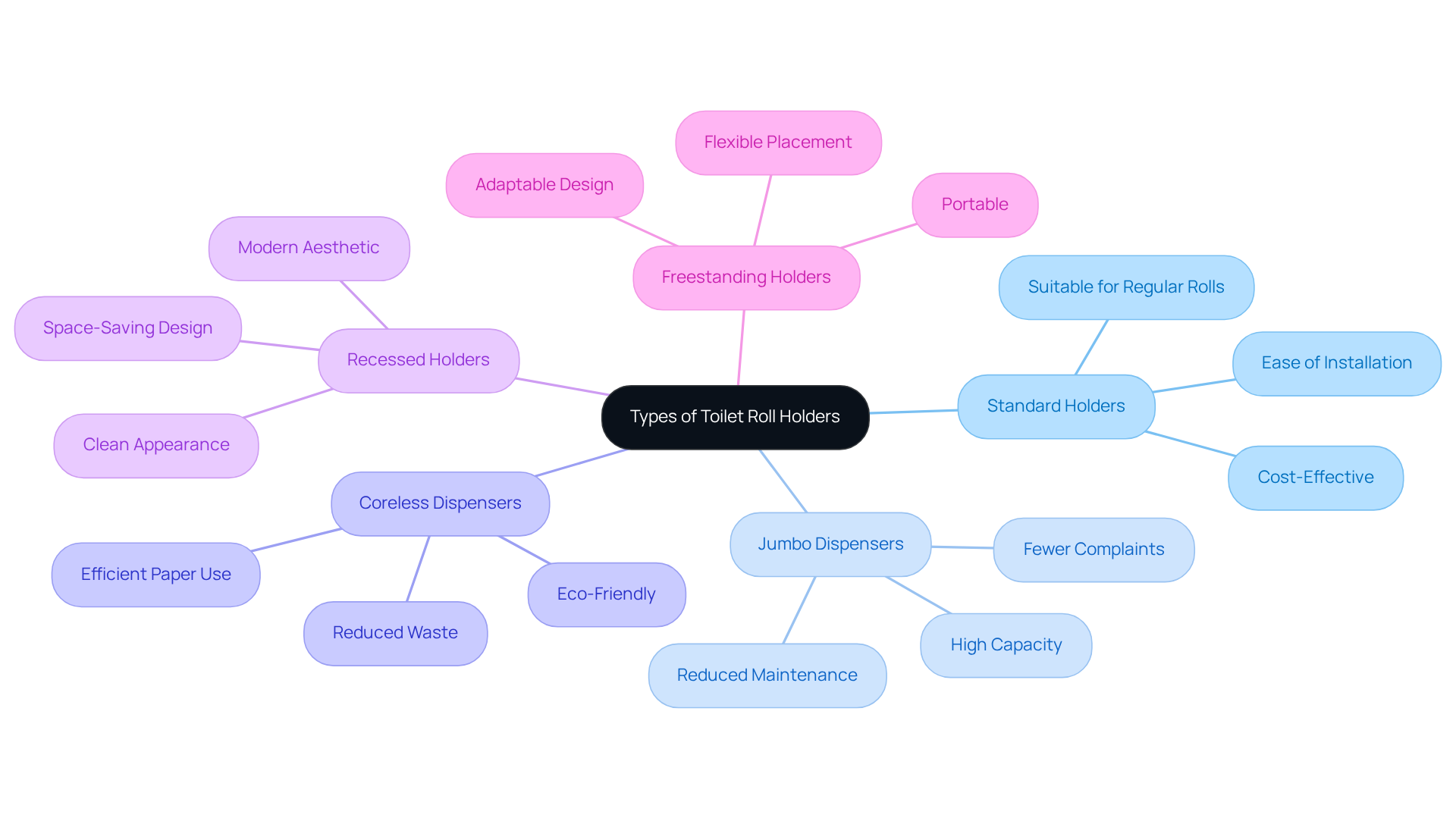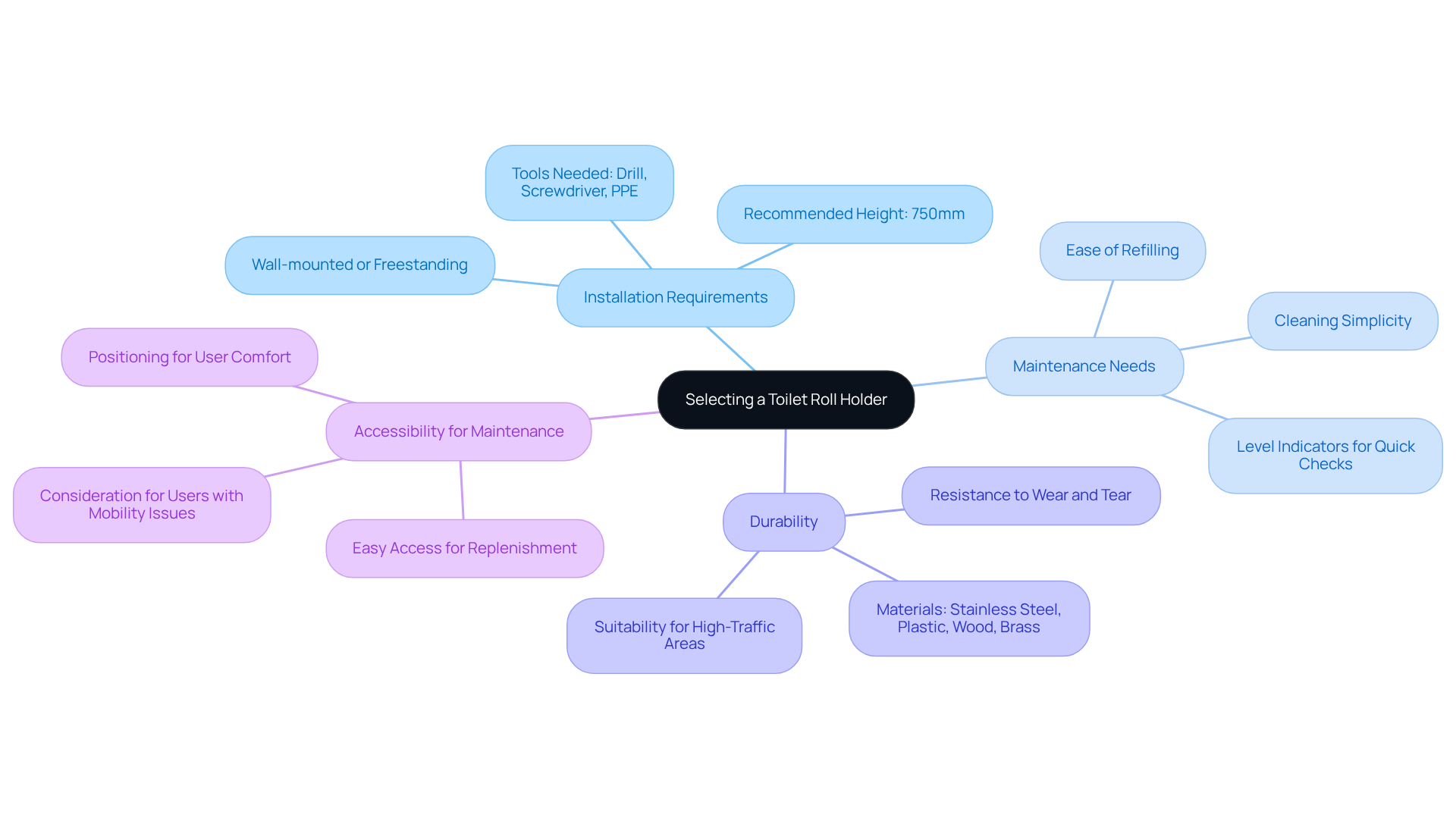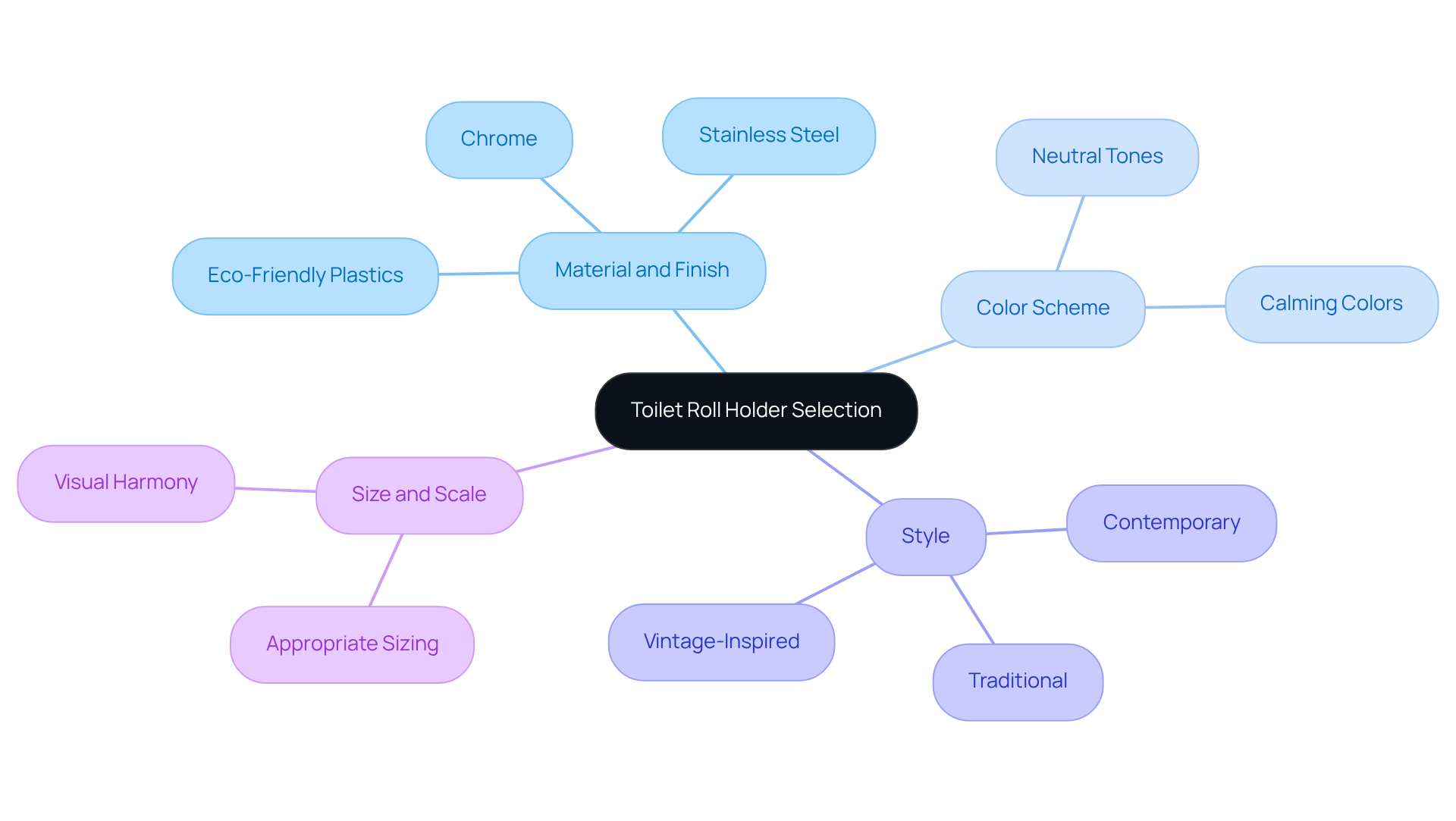Overview
This article primarily aims to delineate the steps necessary for selecting the appropriate commercial toilet roll holder. It emphasizes the importance of:
- Assessing restroom requirements
- Exploring various types
- Considering installation, maintenance, and aesthetic factors
Specific considerations such as:
- Traffic volume
- User demographics
- Design compatibility
are detailed, collectively guiding the selection process. These factors are crucial for ensuring functionality while simultaneously enhancing the overall appearance of the restroom.
Introduction
Selecting the right commercial toilet roll holder transcends mere functionality; it is pivotal in enhancing user experience and upholding hygiene standards in public restrooms. With a diverse array of options available, each tailored to address specific needs—from high-traffic environments to aesthetic considerations—grasping the essential requirements is critical. Facility managers must consider how their choices can fulfill practical demands while simultaneously aligning with contemporary design trends and user expectations.
Assess Your Restroom Requirements
Begin by assessing the specific requirements of your bathroom. Consider the following factors:
-
Traffic Volume: Assess the expected daily usage of the restroom. In high-traffic areas, such as airports or shopping centers, durable and efficient toilet roll holders are essential to withstand frequent use. Statistics indicate that nearly 80% of Americans believe public facilities should feature touchless fixtures, reflecting a growing demand for convenience and hygiene in busy environments. Additionally, 86% of adults believe restrooms in high-traffic locations should display the number of available stalls, underscoring the importance of user experience in these settings.
-
User Demographics: Take into account the age and mobility of your users. Facilities catering to children or the elderly may need supports that are easier to access. For instance, 40% of parents express concern that their children do not wash their hands enough, highlighting the need for user-friendly designs that encourage proper hygiene practices.
-
Restroom Size: Measure the available space for the toilet roll dispenser. Ensure that the support fits comfortably without obstructing other fixtures. In compact facilities, optimizing space is essential, as 72% of adults believe that public stalls lack adequate privacy, which can be worsened by poor design. Thoughtful design can help mitigate these concerns.
-
Accessibility Requirements: If your bathroom must adhere to ADA standards, ensure that the dispenser is placed within the suggested height and distance from the commode. With 53% of adults wanting gaps around stall doors eliminated for enhanced privacy, thoughtful placement of fixtures can significantly improve user experience.
By thoroughly evaluating these needs, you can effectively limit your choices and choose the most appropriate paper dispenser for your bathroom. Case studies from The Splash Lab, including the Padel Haus and Lacuna Space projects, demonstrate how these factors are utilized in practical situations, highlighting the significance of incorporating user requirements into facility design.

Explore Different Types of Toilet Roll Holders
When selecting a commercial toilet roll holder for restrooms, it is essential to consider the various types available, each with unique features and benefits.
-
Standard Holders are the most prevalent option, designed to accommodate regular toilet paper rolls. Their straightforward installation and ease of use make them a popular choice for many facilities.
-
Jumbo Dispensers are ideal for busy bathrooms, as they can fit larger supplies, significantly decreasing the need for replacements. Facility managers often prefer these for their efficiency, as they reduce maintenance time and guarantee a steady supply of sanitary paper. Case studies from The Splash Lab, including those for Padel Haus and Lacuna Space, demonstrate that facilities employing jumbo roll dispensers in high-traffic environments receive fewer complaints about paper availability, thus strengthening their market share in these settings.
-
Coreless Dispensers represent an innovative solution that dispenses toilet paper without a cardboard core, promoting more efficient use of paper and reducing waste. This eco-friendly option aligns with the growing consumer preference for sustainable products, with over 65% of consumers prioritizing eco-friendly options in bathroom accessories.
-
Recessed Holders, installed within the wall, save space and offer a sleek, modern appearance. They are particularly suitable for contemporary bathroom designs, contributing to a clean and organized aesthetic.
-
Freestanding Holders provide portable options that can be placed anywhere in the bathroom, offering flexibility in design and placement. These are perfect for facilities that require adaptability in their bathroom layouts.
Evaluating the advantages and disadvantages of each commercial toilet roll holder type is crucial to determining the best fit for your restroom's needs. For instance, while standard holders are simple to set up, jumbo dispensers excel in busy locations by minimizing upkeep tasks. As we approach 2025, advancements such as smart technology integration—valued by nearly 40% of homeowners remodeling their bathrooms—and eco-friendly materials are transforming the landscape of bathroom accessories, making them not only practical but also stylish and sustainable. Furthermore, maintenance considerations, including how often dispensers need to be replenished and cleaned, should also be factored into the decision-making process.

Consider Installation and Maintenance Factors
When selecting a toilet roll holder, it is essential to consider several key installation and maintenance factors. First, assess the Installation Requirements: Determine whether the holder is wall-mounted or freestanding. Wall-mounted options typically require specific tools and skills for proper installation, ensuring stability and safety. The recommended installation height for toilet paper dispensers is 750mm from the floor in general bathrooms, which enhances accessibility for all users.
Next, consider the Maintenance Needs: Assess the simplicity of refilling and cleaning the container. Designs that facilitate quick refills, such as commercial toilet roll holders with level indicators, can significantly reduce maintenance time, which is crucial in high-traffic environments where downtime can impact user experience.
Furthermore, focus on Durability: Opt for materials that can endure frequent use and resist wear and tear. Common materials consist of stainless steel, plastic, wood, and brass, with stainless steel frequently favored for its strength and durability, making it perfect for high-traffic commercial facilities.
Additionally, ensure Accessibility for Maintenance: Position the support to allow easy access during maintenance tasks. This consideration reduces downtime and improves efficiency, ensuring that washroom facilities remain operational and sanitary.
By considering these elements, you can select a tissue dispenser that not only enhances the bathroom's visual appeal but also guarantees dependable functionality and ease of upkeep over time.

Evaluate Aesthetic and Design Compatibility
To ensure that your toilet roll holder enhances the overall restroom design, it is crucial to consider several key factors:
- Material and Finish: Choose materials that harmonize with other restroom fixtures, such as faucets and sinks. Popular selections include stainless steel, chrome, and eco-friendly plastics, reflecting a growing trend toward sustainability in bathroom design.
- Color Scheme: The hue of the container should align with the overall color palette of the washroom. Neutral tones offer versatility and are often preferred, as they can seamlessly integrate into various design styles while promoting a calming atmosphere.
- Style: Assess the restroom's design when selecting a dispenser. For contemporary designs, sleek and minimalistic supports are ideal, while traditional spaces may benefit from more ornate or vintage-inspired alternatives, which are gaining popularity as part of a broader trend toward nostalgic aesthetics.
- Size and Scale: Ensure that the device is appropriately sized for the space. A large container in a compact washroom can feel overwhelming, whereas a small container in a spacious washroom may seem trivial. Striking the right balance is essential for maintaining visual harmony.
By thoughtfully evaluating these aesthetic factors, you can select a toilet roll holder that not only serves its purpose effectively but also enhances the visual appeal of your restroom, aligning with contemporary design trends and expert recommendations.

Conclusion
Choosing the right commercial toilet roll holder is a critical decision that can significantly enhance restroom functionality and user experience. By carefully evaluating the specific needs of your facility—such as traffic volume, user demographics, restroom size, and accessibility requirements—you can narrow down the options and select a dispenser that meets all necessary criteria.
This article has outlined essential factors to consider, including the various types of toilet roll holders available, installation and maintenance aspects, and the importance of aesthetic compatibility with the restroom design. From standard and jumbo dispensers to eco-friendly coreless options, understanding the advantages and disadvantages of each type ensures a well-informed choice that aligns with both practical needs and design preferences.
Ultimately, investing time in selecting the appropriate toilet roll holder not only improves the overall functionality of the restroom but also contributes to a positive user experience. By prioritizing convenience, hygiene, and design harmony, facilities can create a welcoming environment that meets the expectations of all users. Embrace these insights to make a thoughtful decision that elevates your restroom's appeal and effectiveness.
Frequently Asked Questions
What should I consider when assessing restroom requirements?
When assessing restroom requirements, consider factors such as traffic volume, user demographics, restroom size, and accessibility requirements.
Why is traffic volume important in restroom design?
Traffic volume is important because high-traffic areas, like airports or shopping centers, require durable and efficient toilet roll holders to withstand frequent use. Additionally, many users prefer touchless fixtures for convenience and hygiene.
How do user demographics affect restroom design?
User demographics affect restroom design by determining the need for features that accommodate different ages and mobility levels. For example, facilities for children or the elderly may need easier access and user-friendly designs to encourage proper hygiene practices.
What impact does restroom size have on toilet roll dispenser selection?
Restroom size impacts the selection of toilet roll dispensers by determining the available space for installation. It's essential to ensure that the dispenser fits comfortably without obstructing other fixtures, especially in compact facilities.
What are the accessibility requirements for restroom fixtures?
Accessibility requirements entail ensuring that fixtures, including toilet roll dispensers, adhere to ADA standards, such as being placed at the recommended height and distance from the commode.
How important is privacy in restroom design?
Privacy is crucial in restroom design, as many adults believe public stalls lack adequate privacy. Thoughtful design and placement of fixtures can help enhance user privacy and overall experience.
Can you provide examples of how these factors are applied in restroom design?
Case studies from The Splash Lab, such as the Padel Haus and Lacuna Space projects, illustrate how factors like traffic volume, user demographics, and accessibility are incorporated into practical restroom designs.




